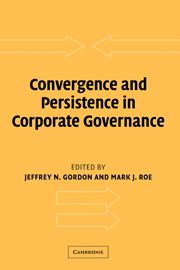Book contents
- Frontmatter
- Contents
- List of figures
- List of tables
- List of contributors
- Acknowledgments
- Introduction
- PART I Systemic issues
- PART II Government players
- PART III Specific institutions
- 8 The politics of corporate convergence
- 9 Ungoverned production
- 10 Convergence of substantive law and convergence of enforcement: a comparison
- 11 Cross-shareholding in the Japanese keiretsu
- Index
- References
11 - Cross-shareholding in the Japanese keiretsu
Published online by Cambridge University Press: 04 March 2010
- Frontmatter
- Contents
- List of figures
- List of tables
- List of contributors
- Acknowledgments
- Introduction
- PART I Systemic issues
- PART II Government players
- PART III Specific institutions
- 8 The politics of corporate convergence
- 9 Ungoverned production
- 10 Convergence of substantive law and convergence of enforcement: a comparison
- 11 Cross-shareholding in the Japanese keiretsu
- Index
- References
Summary
The Japanese corporate “groups” (popularly called the keiretsu) present something of a puzzle. At least as usually recounted, the firms in the group both invest heavily in and trade heavily with each other. The puzzle is why.
In the US, we cite these intra-group trades and investments for a variety of propositions. Implicitly comparing them to spot-market transactions, some observers claim they reflect a distinctively Japanese preference for keeping social contacts within closed groups (Gerlach, 1992). Others tie them to the current debates over path dependence, and claim they prove history matters. For a time, some even called the groups nontariff trade barriers (Lawrence, 1993).
Yet in many ways, group firms invest and trade in ways that reflect straightforward economic calculations. I first describe the groups themselves (section I). I then advance two propositions. First, when group banks trade on member stock, they sometimes (not always) trade on inside information (section II). If US banks do not do the same, in part it is simply because they cannot legally hold stock. Second, the higher cross-holdings before World War II reflected the role that the wealthy families at the center of the groups played as venture capitalists (section III). Group firms no longer play such a role, but only because the wealthy families at their core disappeared in the wake of World War II.
- Type
- Chapter
- Information
- Convergence and Persistence in Corporate Governance , pp. 348 - 361Publisher: Cambridge University PressPrint publication year: 2004
References
- 1
- Cited by

